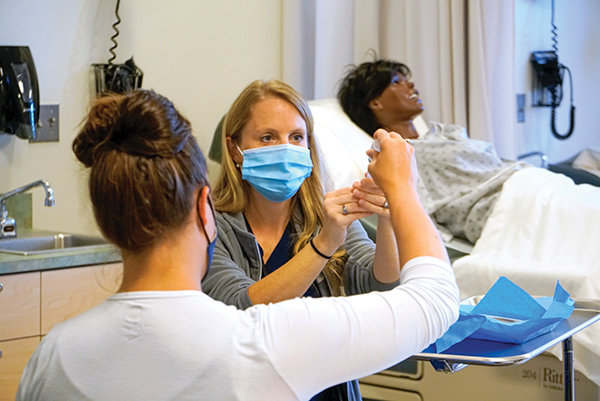
A Manchester Community College instructor and student in the medical assistant certification apprenticeship program. (Courtesy photo)
The acute shortage of health care workers in NH prior to the pandemic has become a crisis in the wake of the Great Resignation. “We had seen a decline in licensed nursing assistants prior to the pandemic,” says Brendan Williams, president and CEO of the NH Health Care Association, a membership organization that supports health care and long-term care organizations. “Prior to the pandemic, we had a crisis. Now we have a catastrophe when it comes to finding workers.”
He, and others in the industry, say the greatest need is for licensed nursing assistants—LNAs—and medical assistants. These are often the entry level position for people entering the health care workforce, and they provide much of the hands-on care at hospitals or nursing homes.
While it was challenging for facilities to fill these positions prior to the pandemic, the additional pressures of the past two-and-a-half years—the challenge of securing protective gear, watching patients die from the virus, and fear of exposing loved ones at home—have pushed many health-care workers to question if they really want their job.
Meanwhile, those left behind are obliged to work longer hours or come in on scheduled days off because there just isn’t anyone else to care for the patients. “We have seen a lot of burnout,” Williams says. “I’ve had baffled members say, ‘where did everyone go?’”
Pay increases can help stem the losses, but they don’t solve the problem. Williams says he knows of facilities that have given three raises this year alone and still struggle to hire. Nursing wages rose by 24% between 2019 and 2021, he says, and continuing to chase higher pay trends could threaten financial stability.
“It feels like an existential crisis,” Williams says. “It is tough sometimes to see how we might get our way out of it. It feels to a lot of our members like an extinction event.”
Measuring the Gap
Between the number of workers on hand and the number needed, there’s clearly a gap. How big that gap is, though, is still an open question.
“We don’t know, we’re trying to quantify it,” says Roxie Severance, a former long-term care facility manager who has worked as a consultant since 2017. She helps to lead the Sector Partnership Initiative, convening employers, educators and community health organizations around the state, by region, to address health care workforce shortages.
Severance and the initiative are in the process of surveying all providers, by region, to come up with a count of how many workers are needed, what kind and where.
“How can the state address it, or anyone else address it, when we don’t know how big the problem is?” Severance estimates that the state is short by at least 1,000 LNAs, though the final figure could end up being closer to 1,500. “Then you look at the community colleges and LNA programs. If enough people wanted to be LNAs, could we train 1,000 of them?”
For someone who is unemployed or underemployed, or is interested in beginning a career in health care, an LNA position offers good pay, guaranteed employment and the chance for professional development. But there’s a barrier. The cost to get certified is about $2,000, which is prohibitive for someone of limited means. It’s important, says Severance, to make grant programs available to remove that barrier.
Then there’s the need for capacity in those certification programs. That capacity is often capped by availability of teachers. The state and federal regulations set requirements for LNA instructors that include at least two years of work experience in a nursing home setting. Anyone who meets these standards would have to take a pay cut to become an instructor.
“The pay is generally so low that you could work in a hospital and make more money, so there’s not the incentive to teach,” Severance says. It’s important to keep the pipeline filled with new LNAs, she says, because many of those new workers will seek higher certification, such as a registered nurse or a nurse practitioner, leaving behind another LNA vacancy.
Until the need is fully quantified, Severance says she worries the situation will only worsen. “It feels to me like there’s nothing big being done. I don’t feel the urgency by others to improve the situation,” Severance says. “I know people are trying to do stuff, but because we don’t have the data, [we] don’t feel the urgency.”
Learn and Earn
One solution already underway takes an old idea, apprenticeships, and applies it to health care, an industry that hadn’t previously offered those. Kristen Miller, vice president of academic affairs at White Mountains Community College in Berlin, says her school helped develop an apprenticeship program in partnership with a hospital.
“One of our partners, Memorial Hospital, came to us in the middle of COVID and said, ‘We need medical assistants, what can we do?’” Miller says none of the existing programs could deliver trained workers quickly enough to fill the hospital’s need, so they started an apprenticeship program.
“We created sections for a cohort of our students. They were hired as medical assistants in North Conway; they were paid full time to go to work, but for 28 hours of that time, they were going to school,” Miller says. The balance of time was spent working in the hospital on tasks they were covering in class. “It was a very active learning environment,” Miller says.
At Manchester Community College, Kristine Dudley, director of workforce development, says she’s been engaging with a statewide effort, ApprenticeshipNH, to offer programs that enable students to become medical assistants, LNAs or patient services administrators. “The best part is, it’s earn while you learn for the participant,” Dudley says.
She says student demand for apprenticeships has been encouraging, but the effort is running into some internal limitations such as instructor capacity.
Another innovation in Manchester taps into the population of recent immigrants and refugees. Many are interested in becoming LNAs, Dudley says, but need help paying for the training as well as English language skills. That program, called LNA for Success, has already graduated two classes and will start its third this fall.
“All of these partnerships we have are really helping to move forward and solve the pipeline issue, but it takes multiple paths to get forward. We have to be open to trying different things and being open to change,” Dudley says.
Endowment for Health Lays Out Strategic Plan for Addressing Pipeline Problems

New Hampshire has a big problem on its hands, and it needs to do something—actually, 107 somethings—and fast. That is the message contained in the “Giving Care: A Strategic Plan” report published earlier this year by the Endowment for Health.
The report notes that NH’s health care labor shortage, already apparent prior to the pandemic, has only worsened and that projections call for a yet more troubling future if nothing changes.
“While over half of the state’s physician assistants are under age 40, 24% of its nurse practitioners and 27% of its primary care providers are over age 60. As well, New Hampshire is projected to be 10th among U.S. states with the most severe nursing shortages,” the report states.
“Giving Care,” a two-year effort involving stakeholders from public and private sectors, education and industry, and all corners of the state, was designed to be a call to action—107 actions divided into four sections: Pipeline, Policy, Data and Governance.
Among the strategies recommended in the report are: creating a statewide financial support system for entry-level and existing workers for educational development, including stipends for students and up-front tuition payment for professional development; encouraging schools to launch an introduction to health care careers beginning with the 5th grade; launching a summer jobs program hiring teens (16+) for jobs in health care settings to influence their entry into health care careers; and implementing strategies to address barriers to licensure.
Kim Firth, program director at Endowment for Health, says the plan has already gained traction, with committees meeting in August to begin “unbundling” the recommendations and building a schedule of actions, with a particular eye to the next state budget and legislative cycles.
“It was very much intended to not be a pie-in-the-sky ten-year plan,” she says.
The full report can be accessed at endowmentforhealth.org/resources.
Firth says anyone considering a career change should look at health care. “This is a great career to get into,” she says. “If you are a member of the health care workforce, we appreciate you. The pandemic has been really difficult on our health care workforce. It’s really important for us to message that we appreciate them and all they’ve done to keep people safe in a really difficult time in our state.”

 Current Issue - July 2024
Current Issue - July 2024